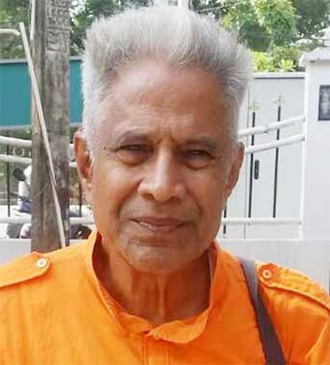A “Hindu” presidential candidate and the “Hindu Tamil Eelam” concept
Wednesday, 10 April 2024 01:29 – – 824
|
 Current media coverage in Sri Lanka is heavily focused on the forthcoming Presidential elections. Though officially not announced yet, it seems a foregone conclusion that the presidential poll would take place later this year. Several potential candidates ranging from incumbent president Ranil Wickremesinghe to media magnate Dilith Jayaweera are tipped to be in the presidential fray.
Current media coverage in Sri Lanka is heavily focused on the forthcoming Presidential elections. Though officially not announced yet, it seems a foregone conclusion that the presidential poll would take place later this year. Several potential candidates ranging from incumbent president Ranil Wickremesinghe to media magnate Dilith Jayaweera are tipped to be in the presidential fray.
Adding to this uncertain state of affairs are recent attempts by vested interests to field a “Hindu” as a common presidential candidate in the 2024 election. Even as people were becoming aware of efforts by interested parties to nominate a Hindu presidential candidate, the head of a Hindu organisation in northern Sri Lanka issued a public statement calling for a common candidate to contest the forthcoming presidential poll on behalf of all Hindus in the island. Furthermore Hindus were asked to vote for Mano Ganesan MP as the presidential candidate.
Kanapathipillai Satchithanandan the founder-leader of the “Siva Senai” (Army of Siva) movement in Sri Lanka issued a statement that was published in the Tamil newspaper “Eelanaadu” of 5 April 2024. Satchithanandan is known as “Maravanpulavu” Satchithanandan and “Maravanpulavu satchi” on account of his native village in Jaffna – Maravanpulavu in the Thenmaratchy division of the peninsula.
Satchithanandan in his statement said that the Hindu religion in Sri Lanka was under grave threat. He alleged that extremists belonging to the Buddhist, Christian and Islamic religions were attempting through various means to reduce the number of Hindus in Sri Lanka. Compared to these three religions, Hindus had little political power in the country.
The “Siva Senai” leader pointed out in his statement that three big elections were expected in due course in Sri Lanka. He called upon the Hindus to voice their support strongly for candidates with deep-rooted Hindu backgrounds in these elections.
Satchithanandan also stated that if a common Hindu candidate contested the presidential election, 20 lakhs of Hindus living in the North, East, West, South and Central parts of Sri Lanka would vote for that person. The Siva Senai leader called upon Hindus to nominate Mano Ganesan as the common Hindu candidate and vote for him at the Presidential poll.

Kanapathipillai Satchithanandan
|
Mano Ganesan
As is well known, Colombo district Parliamentarian, Mano Ganesan is the leader of the Tamil Progressive Alliance (TPA). The TPA formed in 2015 obtained six MP seats at both the 2015 and 2020 Parliamentary polls. The TPA is therefore the largest political configuration representing the Hill Country Tamils (Malaiyagath Thamizhar) of Sri Lanka. Against that backdrop it seemed highly improbable that Mano Ganesan would opt to be the common Hindu Presidential candidate.
This writer contacted Mano Ganesan over this matter and found that the TPA leader was unwilling to be the envisaged Hindu presidential candidate. Referring to Satchithanandan’s statement, Mano Ganesan observed, “That is only his (Satchithanandan) view.” Mano Ganesan also quipped that he was not even a Hindu because he was an atheist.
Though Mano Ganesan will not be the Hindu presidential candidate the efforts of “Hindutva” supporters like the Siva Senai leader are not likely to cease soon. Their attempts will persist. Given the current situation where ancient sites of Saivaite worship are being culturally appropriated and Buddhist Vihares are being constructed in 100% Hindu areas, there is rising Hindu resentment. As such mobilising Hindus to vote for a Hindu presidential candidate appears to be easily possible.
Velan Swamigal
Among potential Hindu contenders for the presidency is the Hindu Yogi Velan Swamigal the head of the religious institution “Sivaguru Aatheenam” in Nallur Jaffna. Velan Swamigal is a Katubedde educated engineer who turned spiritual and donned saffron. After a stint with the Swamy Chinmaya mission, Velan Swamy set up the Sivaguru Aatheenam on his own.
Velan Swamy has participated in several political protest demonstrations and has even been arrested and released on bail. He is therefore a “political Swamy” and is very likely to be the Hindu presidential candidate. Besides he is said to have the backing of “Hindutva” elements in India. Hindutva types have been infiltrating the Hindus of Sri Lanka in recent times. It must be understood that being a Hindu and being a “Hindutva” adherent are not the same though some conflate both through ignorance or for their own benefit.
Hindutva and RSS
What then is Hindutva?
According to the Concise Oxford Dictionary of Politics and International Relations, “Hindutva” meaning “Hindunes” refers to the ideology of Hindu nationalists, stressing the common culture of the inhabitants of the Indian subcontinent.
The Dictionary of Human Geography, says “Hindutva encapsulates the cultural justification of Hindu nationalism, a ‘Hinduness’ allegedly shared by all Hindus.”
A Political and Economic Dictionary of South Asia notes “One of the main purposes behind the concept of Hindutva was to construct a collective identity to support the cause of ‘Hindu-unity”.
“Hindutva” is the core ideology of India’s Rashtriya Swayamsevak Sangh (RSS) in particular and the “Sangh Parivar” (Sangh family) in general. The Sangh Parivar is an umbrella of Hindutva groups led by the Rashtriya Swayamsevak Sangh (RSS), a paramilitary organisation based in India, It was founded in 1925. RSS is at the centre of the Sangh, which sets the priorities and tactics for promoting Hindu nationalist ideals and goals to consolidate the Hindu society and achieve their goal of a “Hindu Rashtra” (Hindu nation).
The Sangh Parivar includes RSS affiliates like Vishva Hindu Parishad (VHP), Bajrang Dal, Bhartiya Janata Party (BJP), Akhil Bharatiya Vidyarthi Parishad (ABVP) and a host of other entities. Some of them are small organisations, cults or political parties.
The RSS had almost 585,000 members and over 57,000 branches or sakhas, including a trade union wing (Bharatiya Mazdoor Sangh), women’s wing (Rashtriya Sevika Samiti), student wing (Akhil Bharatiya Vidyarthi Parishad), and economic wing (Swadeshi Jagaran Manch). The Bharatiya Janata Party (BJP) may be in the seat of power as the ruling party in New Delhi but it is directed and supervised by the RSS. It is estimated that 75% of the ministers in the ruling BJP Government are members of the RSS, including the Prime Minister, Narendra Modi.
“HIndutvaization”
A matter of rising concern is the creeping “Hindutvaization” of Hinduism in Sri Lanka. Sri Lankan Tamil society is pre-dominantly Hindu. Jaffna Tamil Hindus are mainly Saivaite. Though staunchly Saivaite, Tamil Hindu society has been basically tolerant and accommodative. Moreover political problems in Sri Lanka has made Tamils view themselves as Tamils and not as Hindus or Christians. They were victimised not because they were Hindus or Christians but due to the fact that they were Tamils.
Anti-colonial revivalism
It should be noted that the anti-colonialist nationalist revivals of the Sinhala and Tamil people had certain similarities and differences. A moot point was that of religion. Revivalism initiated by Anagarika Dharmapala and Arumuga Navalar was religion oriented and revolved around the Buddhist and Hindu religions respectively.
The continuation of this revivalist process in the post Independence period however saw a major difference. Sinhala political discourse continued in the same vein with Sinhala Buddhist nationalism becoming the dominant ideology among the Sinhala people.
In the case of the Tamil people who saw themselves as the victims of Sinhala Buddhist nationalism the reaction was different. Their response was basically linguistic and not religious. When Tamil nationalism arose in defiance of Sinhala nationalism it became more secular. It was not a Tamil Hindu nationalism.
There are many reasons for this but two significant causes contributing to this were the political leader S.J.V. Chelvanayakam and Rev. Fr. Thaninayakam the Tamil Catholic Scholar. Father Thaninayakam spearheaded a Tamil cultural revival by promoting a worldwide interest in Tamil studies. This made the Tamil proud of his or her glorious heritage.
Tamil speaking people
Chelvanayakam led the Tamil political movement against the imposition of Sinhala. His presence as the great helmsman of the Tamil ship saw him charter a course of secular Tamil nationalism centred on language. The assertion of linguistic nationalism was successful enough not only to embrace Tamil Hindus and Christians but also include the Muslims too at a particular period under the concept of “Tamil Speaking People”. This however did not work out because the Tamil speaking Muslims in Sri Lanka have opted for an ethno-religious identity as opposed to an ethno-linguistic identity.
Hindu-Christian unity under a common Tamil identity however has prevailed. Even the Tamil militant organisations including the Liberation Tigers of Tamil Eelam (LTTE) were essentially secular. However this unity has come under some strain in the post-war years. There are three main reasons for this.
Proselytisation
The first is the irritation and concern caused by the activities of evangelical churches. While the older established mainstream churches have reached a stable “Live and let live” understanding with the Hindus in Tamil areas and do not attempt to convert Hindus to Christianity, the new Evangelical Churches and groups engage in intensive proselytisation. Many of these “New” Christians do not merely tread on, but trample “Hindu” toes with the fanatical zeal and fervour of the converted. This is a major irritant affecting Hindu-Christian relations in many Tamil areas.
Politicians and media
The second is the rise of pro-Hindu politicians and media institutions. There are quite a number of Christians both Catholic and Protestant involved in Tamil politics. These include past and present MPs as well as former Provincial council members and ex-Local authority representatives. What is happening now are covert and overt attempts by some Hindu politicians to derive political mileage by raising the religious cry against potential Christian political rivals. Since the majority of Tamil voters are Hindu, such anti-Christian sentiments are expected to succeed.
Moreover the secular nature of Tamil politics too has begun eroding. There was a time when only the “Thamil Thaai Vaazthu” (Praising the Tamil Mother) was observed at the commencement of Tamil political meetings. Nowadays this is not followed and some events begin with Hindu religious observances.
A leader of a political party attends political meetings with “Viboodhi” (holy ash) daubed on his forehead and begins his talk by chanting Sanskrit verses. There is nothing wrong in wearing Holy ash or chanting Sanskrit Manthras but what must be noted here is that these practices were not followed at political meetings in the past.
What is more of a concern is the blatant anti-Christian sentiments being displayed openly. A former Tamil Parliamentarian who dresses frequently in Saffron like the BJP Chief Minister of Uttar Pradesh, Yogi Adityanath, is viciously anti-Christian in some of his pronouncements to all-Hindu audiences. He also adopts the disgusting habit of emitting deep spit (Kaarith Thuppu) when he sees a Christian priest in Cassock. Another Tamil newspaper has in recent times been propagating the viewpoint that Tamil Hindus should protest against injustices as Hindus and not as Tamils.
RSS-BJP factor
The third reason for waning Hindu-Christian unity is the RSS-BJP factor. The end of the war in 2009 and the advent of the Narendra Modi-led BJP Government in 2014 has led to a situation where a large number of ultra-right Hindu activists visit the Tamil majority areas of Sri Lanka especially the North. These people belong to various small organisations and political parties of the Sangh Parivar. These frequent visits and interaction with Sri Lankan Tamil Hindus have contributed greatly towards deteriorating Hindu-Christian relations in the North.
Among these frequent Sangh Parivar visitors is the infamous founder leader of the Hindu Makkal Katchi (Hindu people’s Party) of Tamil Nadu Arjun Sampath. This well-known Muslim hater and Christian baiter is a native of Coimbatore in Tamil Nadu and was once detained in prison for anti-Muslim violence and for assaulting a Hindu legislator visiting Muslim victims in hospital. Without realising the implications, President Wickremesinghe’s chief of staff Sagala Ratnayake met with Arjun Sampath once. Sampath used the pix to show off that he was very influential with the Colombo Government.
Hindu nation state
Another aspect of the BJP-RSS impact in Sri Lankan Tamil politics is the bogus propaganda about a “Hindu Tamil Eelam”. The dream of a separate Tamil state for the Tamils has ended with the defeat of the LTTE. However there has been a tendency nowadays to propagate that New Delhi was amenable to the creation of a Tamil state if it was a Hindu nation state. The original Tamil Eelam demand was for a Secular state. But now it is being said that the RSS-BJP government would help establish a “Hindu Tamil Eelam” only.
No responsible person in India has ever mentioned a Hindu Eelam, but many low-level operatives of the Sangh Parivar and several deluded vocal warriors of the Tamil Diaspora subscribe to the “Hindu Tamil Eelam” project. These include Sri Lankan Tamil nationalist poet Kathamuthu Sivanandan alias “Kasi Anandan” who has been resident in Chennai for over three decades. The term “Hindu Tamil Eelam” by definition excludes Christians and is a source of Hindu-Christian friction.
Hindu-Christian divide
People like the Siva Senai leader Satchithanandan are among those who exploit this Hindu-Christian divide and widen the chasm further. Satchithanandan once referred to TNA Wanni district MP and TELO leader Selvam Adaikkalanathan as a “Soathuk Katholikkan” (rice Catholic). Some call Christians rice Christians derogatorily on the basis that their ancestors embraced Christianity for a “plate of rice”
On another occasion, Satchithanandan expressed opposition to the composition of a delegation representing the Tamil national Alliance (TNA) at a meeting with a visiting foreign dignitary. The five-member TNA delegation comprised R. Sampanthan, Maavai Senathirajah, Selvam Adaikkalanathan, D. Siddharthan, and M.A. Sumanthiran.
The Siva Senai leader objected to the composition in a statement. Satchithanandan said that 84% of the Tamils in Sri Lanka were Hindus. Yet the TNA delegation had only 60% Hindus. Satchi objected to 16% Christians being given 40% of the representation. What he was alluding to was that Adaikkalanathan was a Catholic and Sumanthiran a Protestant Christian.
Satchithanandan and his Siva Senai often claim credit for stopping Christian revival meetings being conducted in Jaffna. The tactic employed is simple but crudely effective. Leaflets vehemently protesting against such meetings are published and distributed. Veiled threats are issued. Then these leaflets are taken to the Police. A case is made out that there may be a breach of peace if the Christian meetings are held. The Police is “persuaded” to withdraw permission for the meetings at short notice. So meetings are cancelled.
Siva Senai leader Satchithanandam and those of his ilk are seemingly successful in the short term in their anti-Christian action. But in the long term their actions are succeeding in weakening Tamil nationalism by driving the Hindu-Christian wedge in between. In that sense Satchithanandan is accomplishing what the historic enemies of Tamil nationalism have been unable to do in the past – Divide Tamils! The sad irony in this is that Satchi himself was nurtured in the nursery of Tamil nationalism and regards himself as Tamil nationalist still.
“Maravanpulavu Sathchithanandan”
Who is this self-styled saviour of Sri Lankan Tamil Hindus? Kanapathipillai Satchithanandan known as “Maravanpulavu Satchi” or “Maravanpulavu Sathchithanandan” was born in 1941 and educated at Jaffna Hindu College. Satchi obtained a Bachelors degree in Zoology and a Masters degree in Marine Biology from Madras University.
He worked in Colombo as a researcher at the Fisheries Department for several years. After being a victim of racist violence in 1977, he relocated to Jaffna and served as a lecturer at the University of Jaffna. During this time he got elected to the Central Committee of the Ilankai Thamil Arasuk Katchi (ITAK) then a component of the Tamil United Liberation Front (TULF).
In 1979 Satchithanandan obtained a Consultant/adviser post at the Food and Agriculture Organisation (FAO) and worked in 23 countries for many years. After his FAO stint Satchithanandan took up residence in the Tamil Nadu capital of Chennai where he established a publishing enterprise called “Kaanthalagham”. He also engaged in electronic commerce selling books through the website known as “ThamilNool”. While in India he was arrested and detained for several months for allegedly aiding the Liberation Tigers of Tamil Eelam (LTTE).
Satchi moved to Sri Lanka after the war ended in 2009 and set up “Kaanthalagham” in Jaffna. He also aspired to be the chief minister of the Northern Province. After C.V. Wigneswaran was made chief minister, Satchithanandan got estranged from the ITAK. The one-time ardent Tamil nationalist turned into a Hindu chauvinist.
“Siva Senai” (Siva’s Army)
Satchithanandan formed an organisation called the “Siva Senai” (Sivas army) in 2016. It was modelled on the “Shiv Sena” (Sivaji’s army) founded in Maharashtra State by cartoonist Bal Thackeray. Incidentally, Thackeray started the Shiv Sena to drive out Tamils, Malayalees and Telugus from Bombay now known as Mumbai. This did not deter Satchi.
The Siva Senai staged demonstrations against cattle slaughter and selling of beef in the North. It also issued leaflets and pamphlets under counterfeit titles (to avoid being prosecuted) against Christians and Muslims. The call was for Hindus to boycott Muslim businesses and to refrain from voting for Christian candidates. There was also a call for the expulsion of Muslims and Christians from Jaffna described as “Siva Bhoomi” (Lord Shiva’s earth).
At the 2020 Parliamentary elections, Satchithanandan floated a party called the “Saivath Thamizh Thesiyak Katchi” (Saivaite Tamil nationalist party) and contested in the Wanni District as an independent group. The group targeted Hindu votes by attacking Christians and Muslims. The group was trounced at the hustings.
Presidential election
It appears now that the never say die “Maravanpulavu” Satchithanandan is embarking on another political mission of a religious dimension by mooting and promoting the idea of a common Hindu presidential candidate. If he is successful in finding a Hindu candidate on time, it would add colour and spice to the much anticipated 2024 Presidential election. Sri Lankan Tamil nationalism would be further weakened.
(The writer can be reached at dbsjeyaraj@yahoo.com.)
Recent columns
COMMENTS







 Siva Senai leader Satchithanandam and those of his ilk are seemingly successful in the short term in their anti-Christian action. But in the long term their actions are succeeding in weakening Tamil nationalism by driving the Hindu-Christian wedge in between. In that sense Satchithanandan is accomplishing what the historic enemies of Tamil nationalism have been unable to do in the past – Divide Tamils! The sad irony in this is that Satchi himself was nurtured in the nursery of Tamil nationalism and regards himself as Tamil nationalist still
Siva Senai leader Satchithanandam and those of his ilk are seemingly successful in the short term in their anti-Christian action. But in the long term their actions are succeeding in weakening Tamil nationalism by driving the Hindu-Christian wedge in between. In that sense Satchithanandan is accomplishing what the historic enemies of Tamil nationalism have been unable to do in the past – Divide Tamils! The sad irony in this is that Satchi himself was nurtured in the nursery of Tamil nationalism and regards himself as Tamil nationalist still



